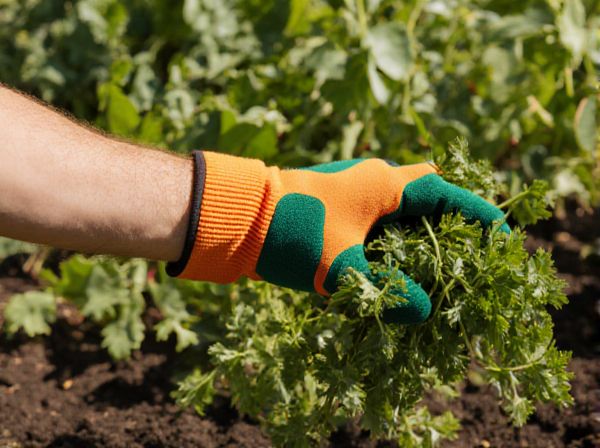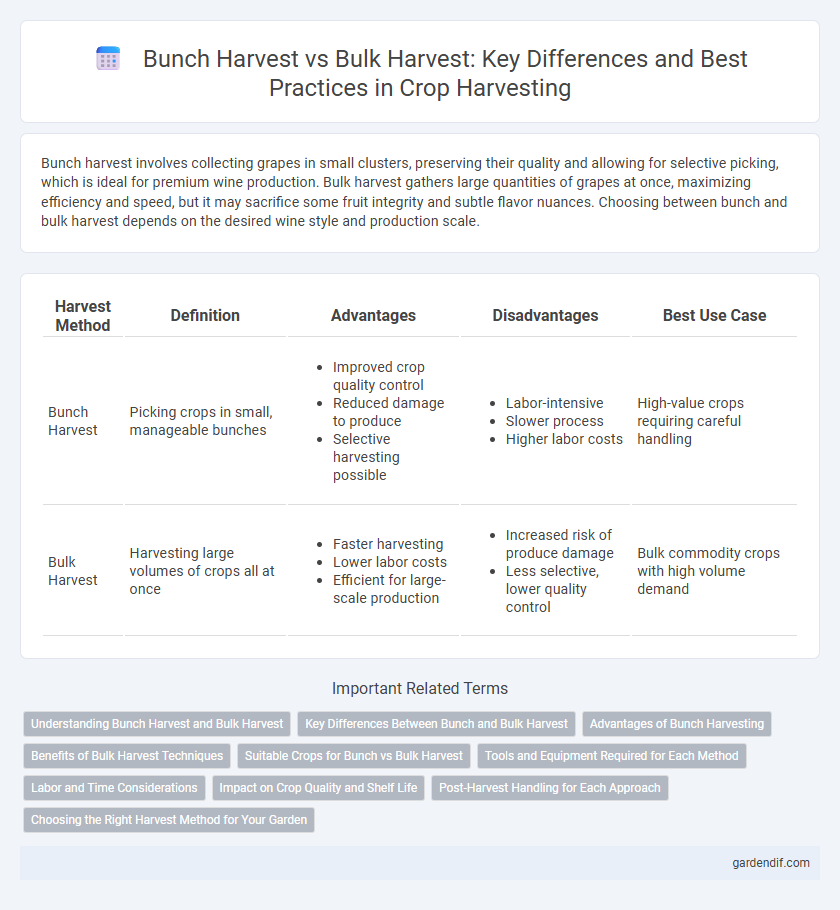
Bunch Harvest vs Bulk Harvest Illustration
Bunch harvest involves collecting grapes in small clusters, preserving their quality and allowing for selective picking, which is ideal for premium wine production. Bulk harvest gathers large quantities of grapes at once, maximizing efficiency and speed, but it may sacrifice some fruit integrity and subtle flavor nuances. Choosing between bunch and bulk harvest depends on the desired wine style and production scale.
Table of Comparison
| Harvest Method | Definition | Advantages | Disadvantages | Best Use Case |
|---|---|---|---|---|
| Bunch Harvest | Picking crops in small, manageable bunches |
|
|
High-value crops requiring careful handling |
| Bulk Harvest | Harvesting large volumes of crops all at once |
|
|
Bulk commodity crops with high volume demand |
Understanding Bunch Harvest and Bulk Harvest
Bunch harvest involves collecting crops in small, manageable clusters, preserving quality and reducing damage during handling. Bulk harvest gathers large volumes simultaneously, improving efficiency but increasing the risk of spoilage and mechanical injury. Understanding these methods helps optimize yield, labor costs, and post-harvest processing strategies.
Key Differences Between Bunch and Bulk Harvest
Bunch harvest involves picking fruits or crops in small, manageable clusters, preserving fruit integrity and reducing damage during handling. Bulk harvest collects large quantities of produce simultaneously, increasing efficiency but often increasing the risk of bruising and quality loss. The key difference lies in the balance between harvesting speed and product quality, with bunch harvest favoring careful selection and bulk harvest prioritizing volume.
Advantages of Bunch Harvesting
Bunch harvesting preserves the quality and freshness of fruits by minimizing damage during pick-up, crucial for high-value crops like grapes and bananas. This method enables selective picking, improving yield by targeting ripe produce and reducing waste. Enhanced handling efficiency and reduced post-harvest processing costs further underscore the economic advantages of bunch harvesting over bulk methods.
Benefits of Bulk Harvest Techniques
Bulk harvest techniques enable faster and more efficient collection of crops, significantly reducing labor costs and time requirements. This method minimizes crop damage by using machinery designed for handling large quantities, enhancing overall yield quality and storage longevity. Improved mechanization in bulk harvesting supports scalability and consistency, making it ideal for large-scale farm operations seeking optimized productivity.
Suitable Crops for Bunch vs Bulk Harvest
Bunch harvest is ideal for crops such as bananas, grapes, and pineapples, where fruits grow in clusters and need careful handling to avoid damage. Bulk harvest suits crops like potatoes, carrots, and beets, which grow underground or as loose units that can be harvested in large quantities without individual sorting. Selecting the appropriate harvest method increases efficiency and minimizes post-harvest losses by matching crop characteristics with harvesting techniques.
Tools and Equipment Required for Each Method
Bunch harvest relies on hand tools such as machetes, sickles, and shears to selectively cut individual stalks, requiring labor-intensive manual handling. Bulk harvest employs mechanical harvesters and combines equipped with cutting heads and conveyors designed for large-scale, continuous crop collection emphasizing efficiency. Choosing tools depends on crop type, scale, and terrain, influencing equipment investment and operational speed during harvest season.
Labor and Time Considerations
Bunch harvest requires more labor and time as workers carefully cut and bundle individual plant bunches, allowing for selective picking and reduced crop damage. Bulk harvest significantly reduces labor costs and speeds up the process by mechanically collecting large quantities simultaneously but may increase the risk of bruising and quality loss. Efficient labor allocation and time management are crucial factors that influence the choice between bunch and bulk harvest methods.
Impact on Crop Quality and Shelf Life
Bunch harvest preserves the integrity of each individual fruit cluster, reducing damage and oxidation, which significantly enhances crop quality and extends shelf life. Bulk harvest, while faster and cost-effective, increases the risk of bruising and contamination due to handling multiple fruits simultaneously, leading to faster spoilage. Choosing bunch harvest methods supports maintaining optimal freshness and market value of perishable crops.
Post-Harvest Handling for Each Approach
Bunch harvest involves cutting and transporting crops in individual clusters, allowing for careful sorting and immediate quality control during post-harvest handling, which reduces damage and spoilage. Bulk harvest collects produce en masse, requiring rapid processing and efficient storage systems to prevent deterioration and maintain freshness. Effective temperature management and prompt drying or cooling are critical in both methods to extend shelf life and preserve product quality.
Choosing the Right Harvest Method for Your Garden
Bunch harvest involves selectively picking groups of mature fruits or vegetables, ensuring minimal damage and promoting continuous growth, ideal for small gardens with diverse crops. Bulk harvest collects all produce at once, maximizing efficiency and speeding up processing but may increase waste and reduce quality for delicate plants. Selecting the right harvest method depends on crop type, garden size, labor availability, and the intended use of the produce.
Bunch Harvest vs Bulk Harvest Infographic

 gardendif.com
gardendif.com